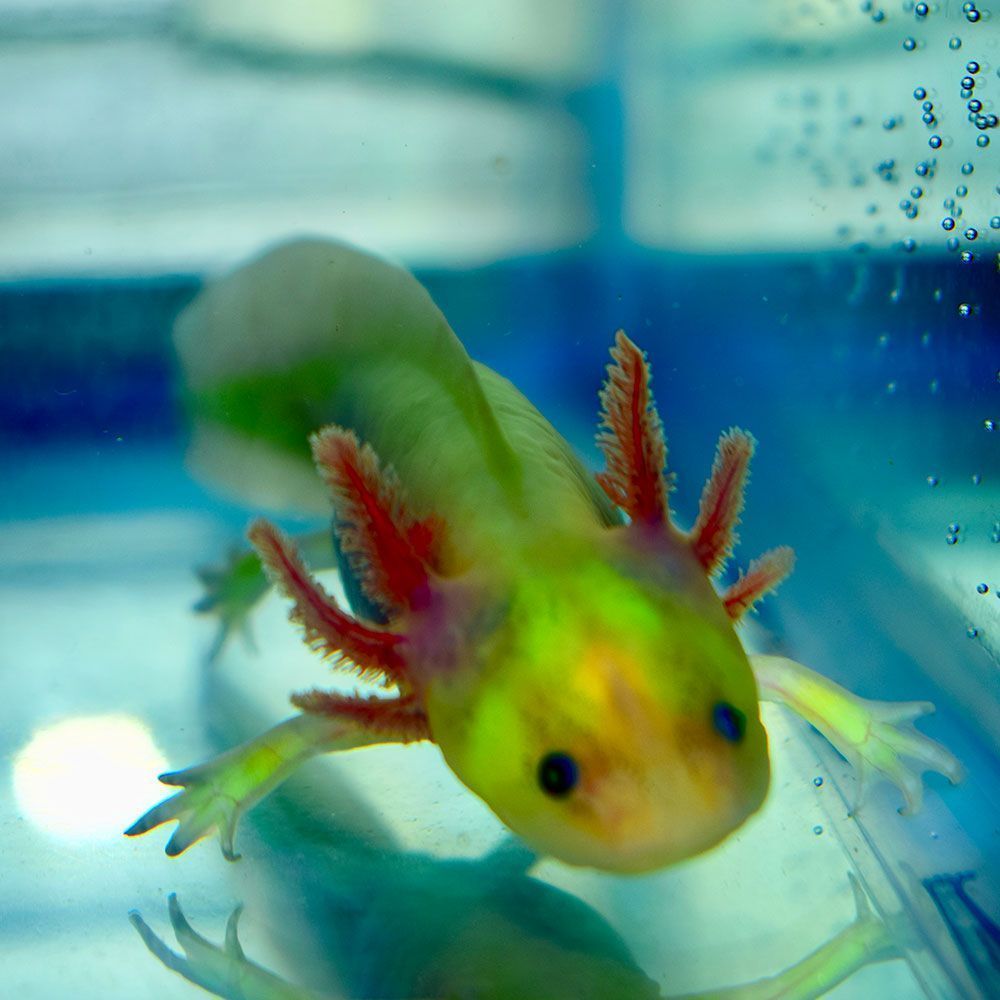GFP axolotl is a unique aquatic pet that is fun to keep and glows in the UV lights. The artificially created axolotl is also popular for being a little larger than the usual axolotls.
It is relatively easy to care for and also a fun companion. While their care needs are the same as other axolotls, owners often use UV lights to enhance their fluorescence.
If you wish to bring this buddy home, keep reading to know about their history, costs, and more.
Note: If you want to adopt and raise this axolotl, check out the main article of the axolotl care for detailed information.
What is a GFP Axolotl?
Also known as Glowmanders, these special transgenic axolotls are leucistic, meaning they have partial loss of pigmentation. They have been genetically modified to express GFP (green fluorescent protein).
This genetic alteration makes them semi-translucent, creating a vibrant green glow.
What is the History of GFP Axolotl?
In the 1960s, Osamu Shimomura discovered the green fluorescent protein (GFP) in jellyfish, paving the way for a groundbreaking revolution.
Douglas Prasher later saw the potential of GFP as a cellular tracer in 1987. Fast forward to today, scientists like Elly M. Tanaka created a transgenic GFP axolotl to explore the regenerative abilities of this remarkable species.
Axolotls can regrow body parts, and scientists used GFP to study this process. They inserted GFP into mutant axolotls lacking skin pigment to monitor limb regrowth.
How to Create GFP Axolotl?
GFP axolotls glow green because of a gene isolated from jellyfish that has the bright-looking yellow-colored green fluorescent protein (GFP), allowing amphibians to glow.
Scientists introduced this gene into axolotls through genetic engineering during their early development.
As they grow, the protein encoded by the GFP gene reacts, making most of their cells glow neon green under ultraviolet light.
Is it Ethical to Create GFP Axolotl?
GFP axolotls are completely ethically created. It neither hurts the axolotl nor causes any side effects on its lifespan or functionality.
Moreover, only the first few GFP axolotls were lab-made. Nowadays, most GFPs are transferred from parent to offspring.
However, it’s mandatory to avoid long exposure of the axolotl to UV lights. Instead, LED lights in soft settings are a better alternative.
How do GFP Axolotl Look?
GFP axolotls appear ordinary at first but glow bright green under UV light. This fluorescence is more prominent in albino or leucistic axolotls with lighter skin.
Normal light shows them as white, grey, or golden. Any axolotl morph can carry GFP genes, making them unique.
What is the Size of GFP Axolotl?
GFP axolotls typically grow to be 25-46 cm (10-18 inches) long, making them larger than other axolotls.
How to Breed GFP Axolotl?
GFP axolotls can be bred, passing on their glowing gene to offspring. However, breeding them requires expertise and understanding of their unique needs.
It’s advised not to follow the same breeding process as mentioned in our main care guide.
Instead, it’s better to consult with experts or do thorough research to provide the right environment and care for both adults and their babies.
What is the Cost of GFP Axolotl?
GFP axolotls are rare, and finding them is tricky, and they cost between $150 and $300, around $50 more than regular axolotls. The price usually depends on factors like age and size.
Remember, ongoing care, including equipment, food, tank maintenance, and vet costs, isn’t included in the initial price. Juveniles are cheaper but require more effort in care.
A word from FishInAquarium
In conclusion, GFP axolotls open doors to a world of fascination, blending the wonders of nature with science.
Whether you’re a science fanatic, a pet enthusiast, or simply intrigued by unique creatures, these axolotls offer endless discovery and joy.
While they require commitment, the rewards of caring for these remarkable beings are immeasurable.
We hope you enjoyed learning about GFP axolotls. If you found this information helpful, consider sharing it with others who might also be equally amazed by this creature.
If you have any questions or need support in your GFP axolotl journey, feel free to reach out via email.


